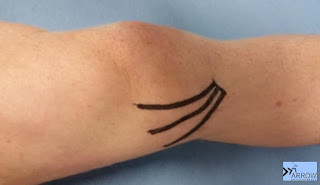Foot pain can be extremely debilitating, not to mention extremely inconvenient given the amount of time we all spend on our feet during the day.
Lately, with the warm weather and people spending plenty of time out and about being active, we’ve seen an increase in foot complaints and in particular, a high number of stress fracture injuries.
A stress fracture is a nasty injury; however, it is important to note that it differs from a regular fracture in many ways.
So here’s the big question: How do you know when you have a stress fracture or are at risk of developing one?
As professional physiotherapists, we see a lot of nasty foot injuries and have extensive experience in picking the difference between stress fractures and standard fractures (as well as numerous other foot complaints).
A stress fracture is the result of repetitive stress imparted on a particular segment of bone, and is therefore classified as an overuse injury. It is not the result of acute trauma. Typical activities that can result in foot stress fractures include dancing, running and jumping activities. We have even seen foot stress fractures recently from excessive walking!
The single greatest contributing factor to a stress fracture is load – that is the volume of activity that you are doing and therefore the cumulative stress that you are putting on the bones in your feet.
Other factors that contribute to developing foot stress fractures include decreased strength and flexibility (especially in your calf and toe flexor muscles), reduced balance, poor biomechanics (including feet rolling in), foot anatomical variances including having a 2nd toe longer than the 1st (known as a Morton’s foot!) and inappropriate footwear. Believe it or not the surface on which you are exercising (too hard) can play a role as can low bone density, poor nutrition and even menstrual irregularities in females.
Combine any number of these risk factors together with a high load of running, walking, dancing or jumping activities and you place yourself at high risk of developing a stress fracture and spending a lengthy period of time away from these activities.
The reality is that stress fractures can occur in any of your bones in your body with repeated stress applied to them and they do! Due to the complicated biomechanics of the foot, and the fact that we spend large portions of the day on our feet transmitting our body weight through these tiny bones, it should come as no surprise to know that stress fractures are particularly common in the feet.
The most important role that we can play as physios is in the prevention of a foot stress fracture. This is achieved through noting the early signs of bone stress which include foot pain after activity (which may not be severe initially) which progressively worsens with activity and focal pain on palpation.
In most cases identifying what needs to be done to avoid a stress fracture of the foot is as simple as having a thorough discussion with the patient to ascertain activity load (and recent changes to this) and conducting an assessment of the lower limb biomechanics. This allows us to identify activity overload or biomechanical issues in the area, as these are the main contributors to injury and their identification is key to prevention.
Once it has been determined that you are at risk, our physios will take a number of steps in order to help you recover and prevent further injury. This will typically include:
- Altering activity load as appropriate,
- Gait/running/jumping analysis and intervening to make appropriate changes as required,
- Assessment and recommendation of appropriate footwear ,
- Personalised stretches, strengthening & stability exercises,
- Potential prescription of supportive orthotics,
- Soft tissue release techniques (e.g. massage, foam roller),
- Taping techniques to de-load the area at risk or to facilitate changes to biomechanics.
If a stress fracture is actually diagnosed in the foot, the aim of treatment is to facilitate optimal healing, reduce pain levels in the early stages and ultimately facilitate return to pre-injury activity, whilst minimising the risk or recurrence. Treatment may include the following (in addition to the things listed above):
- Immobilisation of the foot for a period of time (e.g. moon boot or cast),
- Rest from foot loading activities (e.g. running, jumping, dancing),
- Mobilising with crutches to eliminate/limit stress applied to the foot,
- Use of anti-inflammatory measures (e.g. medications & ice)
- Personalised plan to return to the loading activities that you desire!
Got a foot complaint?
No problem, we’ve got you covered.
Here’s what you need to do:
Simply call us at the practice on 8850 7770 and we will prioritise you as a matter of urgency.
Keep those feet happy!










